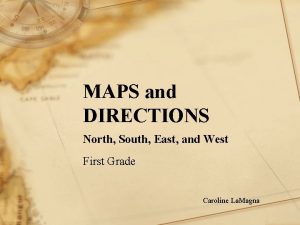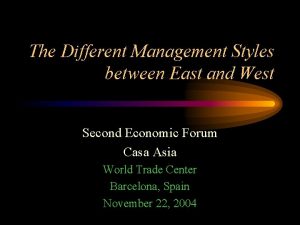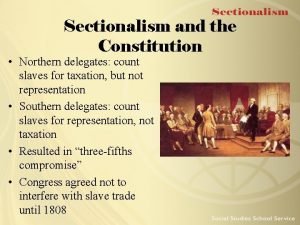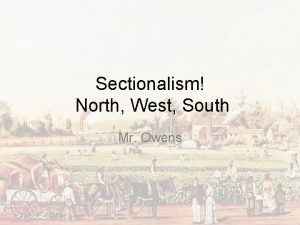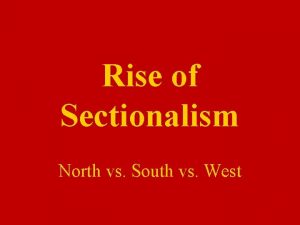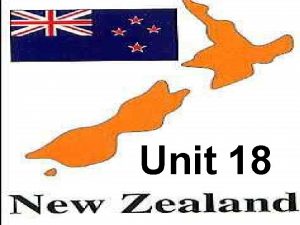Sectionalism North West South Mr Owens Essential Questions






![Southern Society (1850) 6, 000 “Slavocracy” “Cavalier Image” [plantation owners] The “Plain Folk” [white Southern Society (1850) 6, 000 “Slavocracy” “Cavalier Image” [plantation owners] The “Plain Folk” [white](https://slidetodoc.com/presentation_image_h/276d5c67907f59f2dbb8510ae8e8320a/image-7.jpg)



![US Laws Regarding Slavery 1. U. S. Constitution: * 3/5 s compromise [I. 2] US Laws Regarding Slavery 1. U. S. Constitution: * 3/5 s compromise [I. 2]](https://slidetodoc.com/presentation_image_h/276d5c67907f59f2dbb8510ae8e8320a/image-11.jpg)

![1. The Culture of Slavery Black Christianity [Baptists or Methodists] * more emotional worship 1. The Culture of Slavery Black Christianity [Baptists or Methodists] * more emotional worship](https://slidetodoc.com/presentation_image_h/276d5c67907f59f2dbb8510ae8e8320a/image-13.jpg)


- Slides: 15

Sectionalism! North, West, South Mr. Owens

Essential Questions • What were the causes and effects of the rise of the cotton industry in the South and how did connect with the industrial and more urban North? • How did the continued growth and reliance on agriculture contribute to a growing regional identity in the South? • How did regional interests (sectionalism) often trump national political concerns especially on economic policy and slavery?

Industrial & Urban Northeast: textiles, & variety of other goods: farm machinery, clocks & shoes etc. • Organized labor: Working Man’s Party, MA Commonwealth v. Hunt (1842) unions had right to organize & strike • Urban Life: 15% of pop. By 1850, opportunities & problems • African Americans: 250, 000 by 1860 (50% of free blacks) faced major discrimination, denied from unions, limited jobs (used as scabs) Agricultural Northwest: corn & wheat production • Technology: steel plow (John Deere) & mechanical reaper (Cyrus Mc. Cormick) more efficient • New Cities: Chicago, Cincinnati, St. Louis, Buffalo Immigration: surged primarily in North & Northwest The North

Immigration & Nativism Immigration 1820 -1860 Surge due to transportation, problems in Europe & opportunity in America 1. Racism - new immigrants viewed as inferior 2. Belief that they were socially unfit to live alongside “natives” (slums) 3. Workers: immigrants lowered wages or were stealing jobs 4. Protestants - objected to most immigrants being Irish or German Catholics 5. Whigs - Immigrants supported Democrats 6. Politicians - immigrants corrupted politics by selling their votes (political machines) 1840 s in response to surge of Irish & Germans Know-Nothing Party: “The Supreme Order of the Star-Spangled Banner”

The West • American Indians: Exodus west by force or choice west of Mississippi & many adapt to the Great Plains Cheyenne & Sioux (Lakota) nomadic with use of horse • The Frontier: lure of freedom “Mountain Men” ventured West after tales of Lewis & Clark • Settlers on Western Frontier: difficult life in log cabins & “soddies”, disease & malnutrition, conflict w/Native Americans • Women had more responsibilities, difficulties & shorter lifespan • Poor farming techniques led to soil exhaustion & overhunting brought buffalo & beaver to near extinction in certain areas.

The South 1. Primarily agrarian. 2. Economic power shifted from the “upper South” to the “lower South. ” 3. “Cotton Is King!” * 1860 5 mil. bales a yr. (57% of total US exports). 4. Lack of industrialization - De Bow’s Review. 5. Rudimentary (basic) financial system “factors”. 6. Inadequate transportation system.
![Southern Society 1850 6 000 Slavocracy Cavalier Image plantation owners The Plain Folk white Southern Society (1850) 6, 000 “Slavocracy” “Cavalier Image” [plantation owners] The “Plain Folk” [white](https://slidetodoc.com/presentation_image_h/276d5c67907f59f2dbb8510ae8e8320a/image-7.jpg)
Southern Society (1850) 6, 000 “Slavocracy” “Cavalier Image” [plantation owners] The “Plain Folk” [white yeoman farmers] Poor Whites - 500, 000 Black Freemen 250, 000 Black Slaves 3. 2 million (4 million by 1860) (up from 1 mil. in 1800) Total US Population 23, 000 [9, 250, 000 in the South = 40%]

Southern Population

Southern Agriculture

Changes in Cotton Production 1820 1860
![US Laws Regarding Slavery 1 U S Constitution 35 s compromise I 2 US Laws Regarding Slavery 1. U. S. Constitution: * 3/5 s compromise [I. 2]](https://slidetodoc.com/presentation_image_h/276d5c67907f59f2dbb8510ae8e8320a/image-11.jpg)
US Laws Regarding Slavery 1. U. S. Constitution: * 3/5 s compromise [I. 2] * Article IV Section 2 fugitive slave clause 2. 1793 Fugitive Slave Act illegal to assist escaped slaves fugitives for life - slave catching industry 3. 1850 stronger Fugitive Slave Act - stronger punishment and slaves couldn’t testify - rewards.

Emancipation in the North But these dates are misleading - PA law freed newborns at 28 - some slaves in 1830 s - NJ 1860 s.
![1 The Culture of Slavery Black Christianity Baptists or Methodists more emotional worship 1. The Culture of Slavery Black Christianity [Baptists or Methodists] * more emotional worship](https://slidetodoc.com/presentation_image_h/276d5c67907f59f2dbb8510ae8e8320a/image-13.jpg)
1. The Culture of Slavery Black Christianity [Baptists or Methodists] * more emotional worship services. * negro spirituals. 2. “Pidgin” or Gullah languages. 3. Nuclear family with extended kin links, where possible. 4. Importance of music in their lives -esp. spirituals RESISTANCE 1. “Sambo” - slaves playing up to stereotypes around owners 2. Defiance - Refusal to work hard. 3. Theft & isolated acts of sabotage. 4. Escape via the Underground Railroad. 5. Revolt – Nat Turner’s Rebellion 1831, VA

“Sold Down the River” • Upper South - years of tobacco had exhausted soil in Virginia, Maryland, & NC • Expanding demand for slaves in Deep South for cotton • “Breeding plantations” • 1790 -1860 1 million slaves sold “down the river” - also used as punishment • 250, 000 slaves shipped in 1850 s alone

Southern Pro-Slavery Propaganda What is the message?
 East south east wind direction
East south east wind direction West north west wind direction
West north west wind direction Political map of north africa and southwest asia
Political map of north africa and southwest asia North east west south map
North east west south map Lines that run north and south
Lines that run north and south Alaska arizona arkansas
Alaska arizona arkansas Fifty united states
Fifty united states North south east west leadership styles
North south east west leadership styles North east south west
North east south west North, south east west leadership styles
North, south east west leadership styles North south east west direction
North south east west direction World map with latitude and longitude pdf
World map with latitude and longitude pdf West sectionalism
West sectionalism North and south lesson 1 the industrial north
North and south lesson 1 the industrial north Essential non essential fatty acids
Essential non essential fatty acids Noord oost zuid west ezelsbruggetje
Noord oost zuid west ezelsbruggetje



